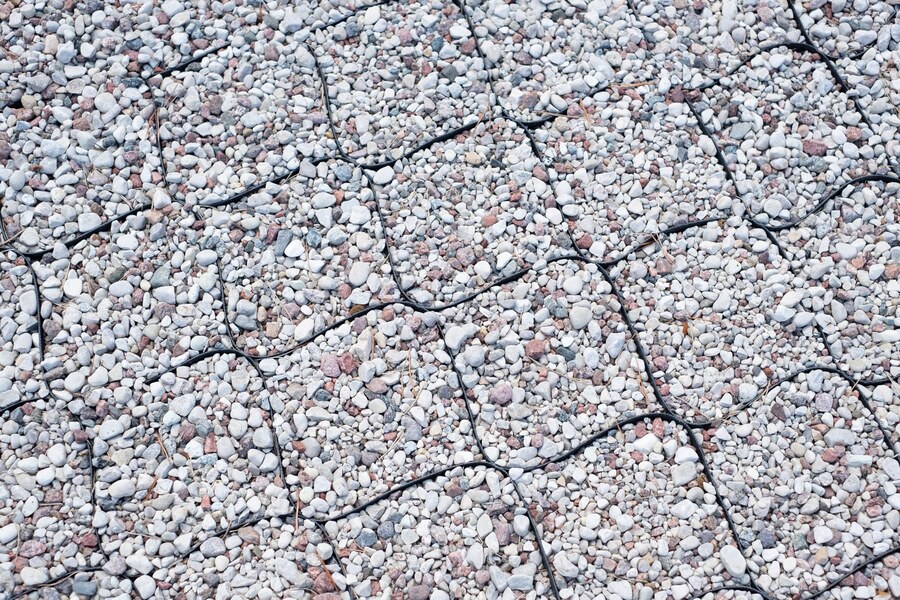We know how difficult it is to maintain the integrity of your gravel driveway or your dirt parking pad. Flooding and excessive use can cause the surface to shift. To help you solve this, our team at Performance Footing has developed the highest quality Geocell Base-Core. But what are Geocells?
Geocells are cellular confinement systems that were created as an easy and durable material that are used for stabilizing and protection. Cellular confinement systems effectively maintain the soil’s compaction, and, by doing so, create a stronger structure for both the infill and pavement.
The cells’ three-dimensional, honeycomb design ensures that the Geocell is strong and durable. This format creates a structure that improves load distribution.
The cell is made from a high density polyethylene (HDPE), which is used to stabilize weak or unsteady soil. That ability is a result of their ability to reduce lateral movement of soil particles while vertically loading on the contained infill.
In addition to the stability, Geocells also provide a mattress effect and improve the elasticity of the materials. The cells have a high elastic stiffness and high tensile strength, and because of this, they improve the load distribution of the product.
Because of the weight distribution that the cells create, less rutting occurs in the surface materials above. This also reduces the required granular infill. The cells’ design allows for the infills to be imported locally, which also enables the use of marginal soil for infill.
Lastly, Geocells improve the asphalt layers of the product, which leads to many benefits. The first is the ability to use less asphalt, due to the fact that the cells have a longer lifespan than regular asphalt. Secondly, with the transfer of vertical forces to the geocell grid by passive resistance, Geocells improve the modules of adjacent layers. The ability to use Geocells greatly helps save in the base and subbase layers, directly affecting the upkeep and cost for users.
History of Geocells
Engineers created and developed Geocells to protect and stabilize various conditions of the ground world-wide during the late 1970s and early 1980s. In the early stages of Geocell development, their application was significantly different than what we see today. Originally, it was implemented primarily to stabilize sand roads for transporting military grade vehicles.
The very first designs of Geoells consisted mostly of recycled materials such as wax-coated craft paper, plastic drainage pipes, and staples. Geocells were rapidly improved due to their immediate need in places, such as in the middle east when the U.S military started operating in combat zones.
Later, the U.S Army contacted Presto Products, a plastics manufacturer. Together, they created a much stronger grid that would be able to maintain even more weight for military applications. The original Geocells were tested in Florida by building sand roads out of the material, while the newer cells were tested by trafficking many vehicles across their makeshift road. Even with many military-grade vehicles, the cells showed no signs of distress.
However, this did not slow the need for improvement of the cells. Slowly, the product became more refined as the demand for Geocells increased, mostly for bigger projects and less for civilian application. Since the 1980s, Geocells have gained a lot of popularity in a lot of different departments outside of the military due to its great design.
The Uses of Geocells
Geocells are very useful because of their ability to expand, allowing materials to be compacted inside. This expansion creates a free draining system that still inhibits mass movements that other construction materials and processes can not prevent.
Their high-quality design means that Geocells are diverse and multi-functional. One of the main uses is for protecting structures. For instance, large corporations use the cells for protective linings to protect their hydraulic structures and various kinds of industrial equipment.
Another great use of the cells is for the protection and stabilization of steep slope surfaces. Geocells are used in mountainous areas not only to stabilize the ground, but also to make roads stronger and improve their life.
A great example of this is an Avalanche Protection System in Iceland. The original plan was to construct a concrete retaining wall, but instead they constructed various Geoweb barriers to keep the city safe from avalanches.
There are other uses for Geocells such as the improvement of static and dynamic load support on weak subgrade level soils. An example of this is the Geoweb in Britain, where the very soft sand that was used near the city of Kent would shift. This was a perfect application for the Geocell, as it was used to both stabilize the ground and create strong roads.
They also are used for multi-layered earth retaining and water retaining gravity structures. An example of this is a retaining wall in Korea, the main purpose of which was to stop the effects of erosion that is caused by major weather in cities near the wall.
Today, Geocell serves as an affordable, useful stabilizer for your residential needs. Whether you have a parking pad that is constantly flooding or are looking to stabilize your driveway, Performance Footing has what you need. Our Geocells will improve the quality of your surfaces and prevent damage down the road.
If you are interested in our Geocell, please contact us today.
